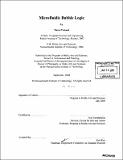Microfluidic bubble logic
Author(s)
Prakash, Manu
DownloadFull printable version (26.40Mb)
Other Contributors
Massachusetts Institute of Technology. Dept. of Architecture. Program in Media Arts and Sciences.
Advisor
Neil Gershenfeld.
Terms of use
Metadata
Show full item recordAbstract
In this thesis, I propose a new paradigm in computing where bits can simultaneously transport and manipulate materials and information. Information representation is invariably physical. Though this insight is fundamental to understanding the physical limits of computation, it has never been exploited as a scheme for material manipulation. Bringing together notions from computer science and fluid dynamics, I present a new logic family "Bubble Logic" capable of both universal computation and programmable material manipulation in an all-fluidic two-phase system. This removes the distinction between materials and mechanisms to control them, bringing the programmability of the digital world into the physical world - with a wide range of promising applications in biotechnology, highthroughput screening, genomics and fluidic control systems for soft robotics, printing and digital fabrication.Microfluidics, the art of handling nano-to pico-liter volume fluids, is leading to a revolution in large-scale automation of biology and analytical chemistry. However, current lab-on-chip technologies are dependent on external macro-scale control elements, thus requiring a lab to run the chip. Bubble logic provides a dropletel,internal, inherently digital flow control mechanism at kHz frequencies with no moving parts or off-chip components. Nonlinearity is introduced in an otherwise linear, reversible, low Reynolds number flow via bubble-tobubble hydrodynamic interactions. I demonstrate bubble logic AND/OR/NOT gates, a toggle flip-flop, a ripple counter, a timing restoration device, a ring oscillator, a bistable valve and an on-demand bubble generator. These show the nonlinearity, gain, bistability, synchronization, cascadability, feedback and programmability required for scalable universal computation and control. (cont.) The representation used in this thesis makes possible encapsulation and manipulation of a large variety of micro-to nanocale materials including single molecules like DNA or proteins, live cells, liquid crystals, nano-particles and other biological and chemical reagents. Bubble logic provides a scheme to transport, store and operate on this new class of "digital materials" in an integrated, high-throughput fashion. Furthermore, microfluidics has also been extensively employed in biological systems. This thesis describes the discovery of two new physical fluid dynamic mechanisms motivated by a common theme of microfluidics in biology. Firstly, I describe a new superhydrophobic waterrepelling surface that has a characteristic of directional anisotropy to fluid resistance. The discovery, made while studying the integument of water-walking insects, helps rationalize the origin of thrust and hence propulsion of water-walking insects on a fluid interface. Secondly, this thesis uncovers a new physical mechanism for directed droplet transport, which I term "Capillary ratchet". Discovered in a class of surface feeding shorebirds, it is the only physical mechanism that is known to exploit contact angle hysteresis for fluid transport. Capillary ratchet is a promising candidate for implementing global clocking for integrated microfluidic devices.
Description
Thesis (Ph. D.)--Massachusetts Institute of Technology, School of Architecture and Planning, Program in Media Arts and Sciences, 2008. "September 2008." Includes bibliographical references.
Date issued
2008Department
Program in Media Arts and Sciences (Massachusetts Institute of Technology)Publisher
Massachusetts Institute of Technology
Keywords
Architecture. Program in Media Arts and Sciences.